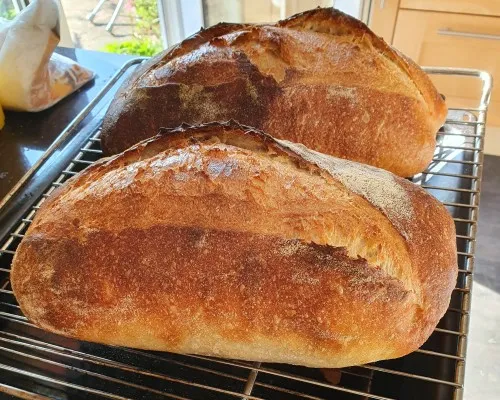
I've made Abel's 90% Biga loaf several times since he published it and in my view it's a TFL classic. However, although I've had great results with the yeasted version, I've never had success with the sourdough one.
However, a recent comment from DanAyo (near the bottom of Abel's thread) made me want to revisit it. Guidance from Michael Wilson (in the same thread) helped me understand that I wasn't using the "right" sourdough for the recipe and that I needed a low acid Lievito Madre type starter to be successful.
So on his advice I repurposed my starter (normally 80% BF/20% rye and 80% hydration) into a pseudo lievito madre one - all white at 50% hydration.
Levain
Day0: build 1 & 2 at 1:2:1 (starter:BF:water) 25C
Day0: build 3 at 1:2:1 18C and stored overnight underwater at 18C
Day1: take starter out of water and drain. Build 1 at 1:1:0.5 28C
Build 2 & 3: repeat build one every 4 hours. Levain should triple
Biga (50% hydration)
300g Marriages BF
300g Marriages Canadian flour
300g water
60g levain
Day 1, e11: mix till no more dry flour. Chop up biga into small pieces and store loosely covered at 16C
Main Dough (67% hydration)
All biga
395g Grandi Molini Tipo 0 flour
5g diastatic malt
377g water
19g salt
Day 2, m10: not much rise on biga, which I think is fine, but warmed up for 1 hour in PB at 28C
Day 2, m11: add water to mixer and then half flour. Mix on slow until smooth and then incorporate chopped up biga
Add rest of flour and mix on slow until smooth.
Mix on high 1 min, add salt and mix for another minute.
Turn out of the mixer into proofing bowl, dough temp 23C
Bulk ferment at 28C for 3hrs 25mins with one coil fold - about 40% volume increase.
Preshape to 2 x 850g batards. BR 20mins
Shape, proof for 70mins at 28C
Score and bake as normal with steam
Thoughts
Do you need a long bulk like I did with a SD biga? Anyone know?
Very difficult to score - I always find this with biga loaves - it must be the long biga ferment degrading the dough
Ears and loft OK, but not great
Super open crumb
Mild flavour - I guess as expected from using the low acidity LM
Photos
Lievito madre in water bath at start:
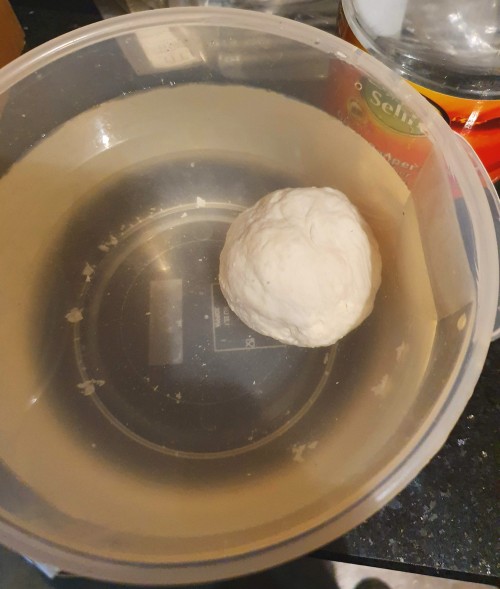
Lievito madre drained, next morning:
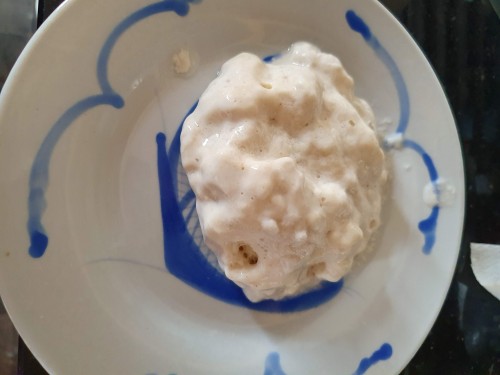
Biga:

Last of the biga just before adding to the mixer: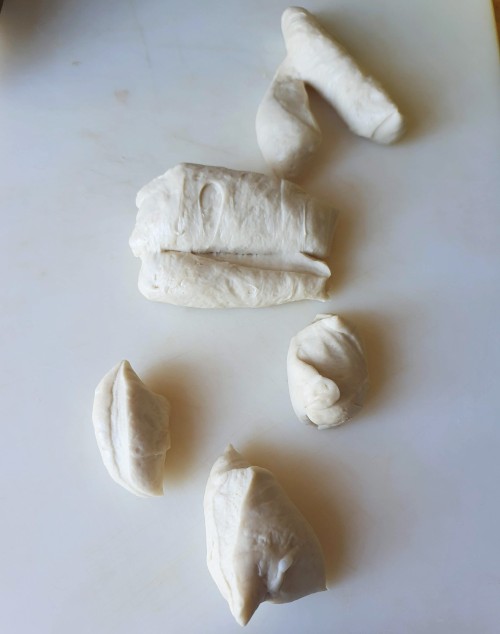
Baked loaves:
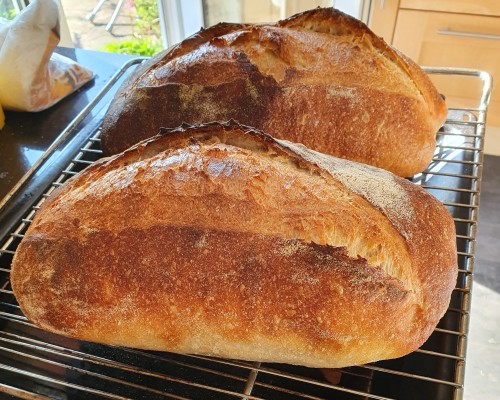
If open crumb offends you, look away now!:
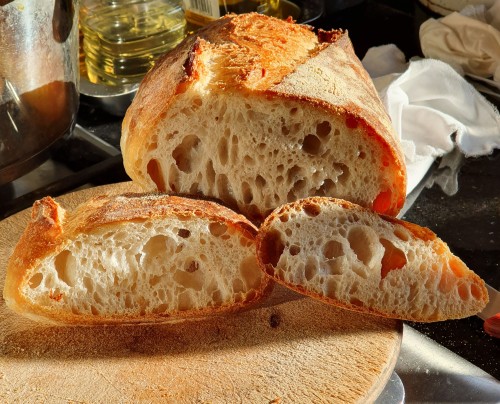
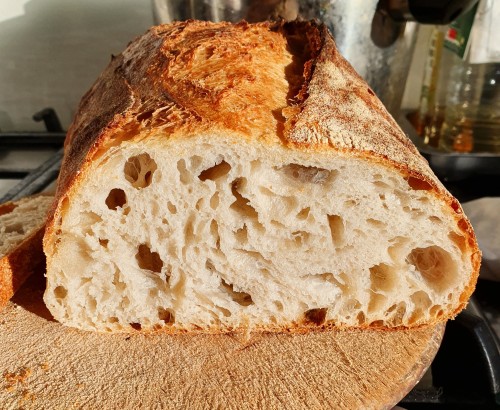
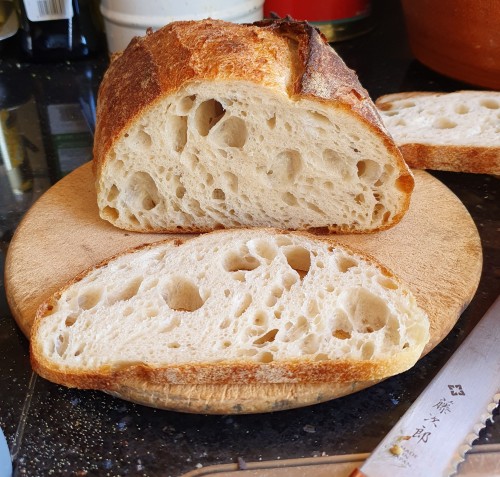
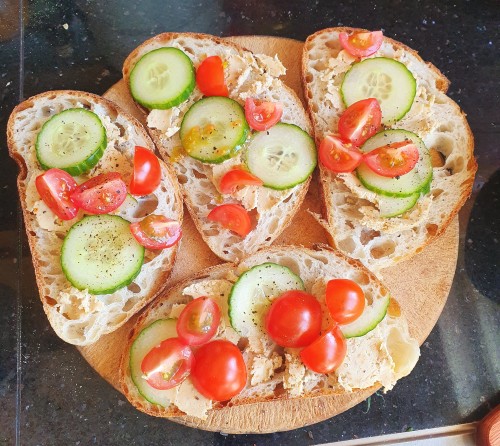
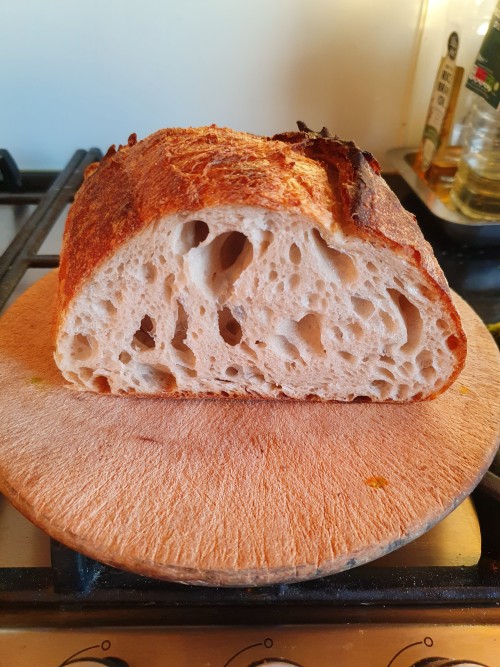
Lance
- albacore's Blog
- Log in or register to post comments
Lance the loaves look great to me, the crumb looks nice and open.
This bread seems pretty complex with more processes going on than I am used to. Is the use of the levito madre and the biga for any particular reason? Does it impart more flavour to the bread or is it some other reason?
Benny
As you say, the bake is quite complex in procedure, although simple in ingredients.
You can split the procedure into biga and lievito madre. The biga part is relatively simple and can be yeasted for greatest simplicity.
It comprises a 10-16hr stiff preferment at 45-50% hydration with 1% fresh yeast (or dry equivalent) at 16-19C. The biga flour is anything from 33% to 100% of the total flour.
The biga gives lots of flavour and open crumb, with good crust and keeping properties for a yeasted bread. See Abel's original post (which I linked to in my blog post) for his 90% biga loaf, which many on TFL have tried, some more successfully than others. I think that without a powerful mixer (which I am lucky enough to own), it is difficult to mix the biga into the main dough.
I went down the LM route as a bit of an excercise as it's something I've never dabbled with before - it might be useful if I ever want to make Pannetone!
But I'm not sure I'll use it to make biga again as the flavour is so mild, for me it's not really any improvement on the yeasted version.
Lance
You have really seen an improvement and I'm glad I could help out with this. The crumb is really good, I can see lots of strength in it and I think you could easily up the final hydration if you attempt this again. Doing so may improve the loft.
I remember going to 80% total hydration, it was a puddle to begin with but after a short rest the biga showed its strength and I ended up with a "spiderweb-like" crumb.
The shot of the LM in taken from the water looks like it has degraded more than is optimal which signifies still too much bacterial action. This may explain the difficulty with scoring. Really it should have been a breeze.
I find the bread I make with my LM always gives me a softness that can't be matched with full-on SD. The flavour may be subtle but there is for me a moreish quality to it. I think low acid gives way to better fermentation and an expression of the natural wheat flavours. That's not to say there is no acid component, with the right balance the warming qualities of lactic acid come through. Sometimes my LM has a potent aroma of honey about it!
Maybe try cutting the final mix with some ancient grain flour next time.
As general a rule the larger the pre-ferment (levain) the shorter the bulk required.
The biga looks cool, did it smell acetic and alcoholic?
All in all a really good bake, well done!
Like you said to Benny this procedure heavy exercise can be preparation for a panettone bake!
Michael
Thanks Michael; do you have a picture of LM in better shape after the water bath?
Also, how to store LM between uses - is dry storage in the fridge acceptable?
Lance
Did you see my video:
For periods lasting more than 4hrs, storage (conservation) is best with either the "in water" method or the bound method. Storage can be a max of 24 hours at 18C max. For longer periods at fridge temperatures the feed ratio should be adjusted 1:3 or 1:4 (starter:flour). Personally I go for the bound method when storing in the fridge (for me I use a wine cooler set to 8C) and that can stay there for a week. A refresh in the warmth i.e.. 28C would be needed after that, done at least once before being put back into storage mode.
Hello, I guessed some abbreviations in your post but what are BF, SD, and LM? Thank you.
BF = bread flour
SD = sourdough
LM = lievito madre, also known as pasta madre
You may also come across AP, which is all purpose flour, but that doesn't exist in the UK.
We could probably do with a full list of abbreviations on TFL as some kind of "sticky". I know some people hate them, but they make writing posts a lot easier! They are also useful if you are writing your own recipes or records of bakes.
Lance